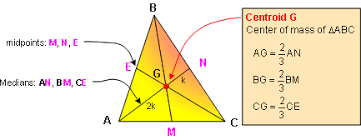
Given A (4,2), B (2, -3), C (8, -2)
Dilated around point D(-3, -1) by a factor (1/3)
To find the distance moved by the centroid
#vec(A'D) = (1/3) * (vec(AD))#
#a' = (1/3) * (a -d) - d = (a/3) + ((2d)/3)#
#a' = (1/3)((4),(2)) + (2/3)((-3),(-1)) = color(purple)(((-2/3),(0))#
Similarly #b' = (1/3) * (b -d) - d = (b/3) + ((2d)/3)#
#b' = (1/3)((2),(-3)) + (2/3)((-3),(-1)) =color(purple)( ((0),(-5/3))#
#c' = (1/3) * (c -d) - d = (c/3) + ((2d)/3)#
#c' = (1/3)((8),(-2)) + (2/3)((-3),(-1)) =color(purple)( ((2/3),(-4/3))#
Centroid #G = ((a_x + b_x + c_x)/3, (a_y + b_y + c_y)/3) = color(green)(((14/3), -1)#
Dilated centroid point #G' = ((a_x' + b_x' + c_x')/3, (a_y' + b_y' + c_y')/3) #
#G' = ((-2/3) + 0 + (2/3))/3, (0 + (-5/3) + (-4/3))/3 =color(green)( (0, -3)#
Let's use distance formula to find the distance moved by G to G' after dilation
#vec(GG') = sqrt((G_x - G_x')^2 + (G_y - G_y')^2)#
# => sqrt(((14/3) - 0)^2 + (-1 - (-3))^2)#
#GG' = sqrt ((14/3)^2 + 2^2) ~~ color(red)(5.08)# units (rounded to 2 decimals)

